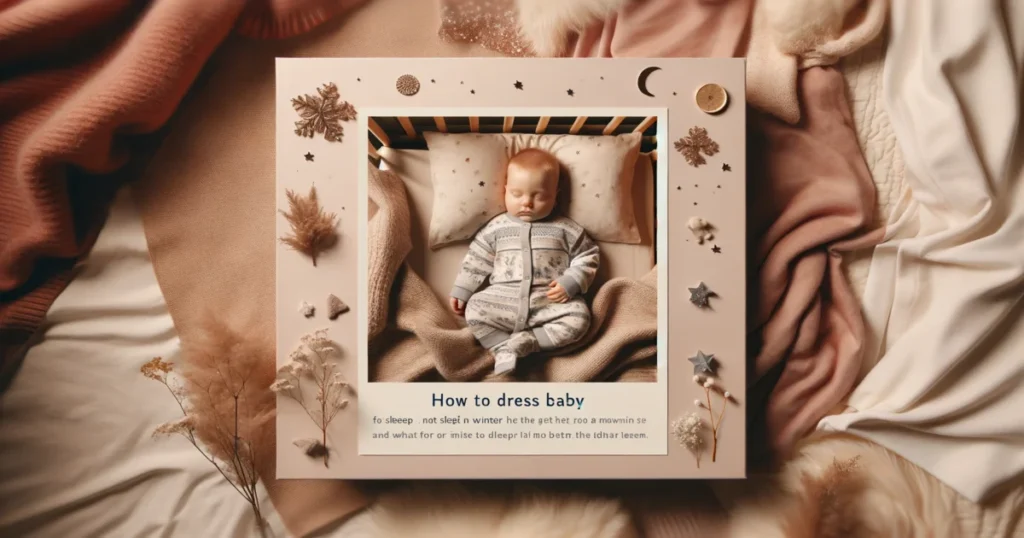Introduction of How to Dress Baby for Sleep:
As winter approaches, many parents wonder how to dress baby for sleep to ensure they stay warm and comfortable throughout the night. This guide offers straightforward, expert-backed strategies to help you choose the right sleepwear for your little one during the colder months.

We’ll cover everything from understanding the importance of layering to selecting the right fabrics, ensuring your baby sleeps safely and cozily. This article ‘how to dress baby for sleep’ is an essential read for any parent looking to provide their baby with a restful and snug sleep environment in winter.
Key Factors in Choosing Winter Sleepwear for Baby:
Understanding how to dress your baby for sleep during the chilly winter months is crucial for their comfort and safety. The right winter sleepwear keeps your baby warm without overheating, ensuring a peaceful and safe sleep. It’s all about finding the perfect balance between warmth and breathability.
Tip: Opt for layering with breathable fabrics like cotton to maintain a comfortable body temperature for your baby during sleep.
Mastering Layering for Baby’s Winter Sleep:
Layering is an effective strategy when dressing your baby for sleep in winter. It allows you to adjust your baby’s warmth as needed, adding or removing layers to respond to their comfort and the room’s temperature.
Tip: Begin with a light cotton onesie and add a warmer layer, such as a fleece sleeper, adapting as necessary throughout the night.
Choosing Comfortable and Safe Fabrics for Baby’s Sleepwear:
Selecting the most suitable fabric is a vital aspect of dressing your baby for sleep in winter. Fabrics that offer warmth while allowing the skin to breathe, like cotton and fleece, are ideal choices. These materials provide the necessary warmth without the risk of overheating.
Tip: Look for sleepwear made from natural fibers for the layer closest to your baby’s skin, ensuring maximum comfort and breathability.
Optimizing the Nursery Temperature for Baby’s Sleep:
Maintaining an ideal room temperature is key when you dress your baby for sleep. It’s important to prevent overheating, which can be uncomfortable and unsafe for your baby. A cool, comfortable nursery promotes better sleep.
Tip: Keep the nursery at a moderate temperature, typically around 18-20°C (65-68°F), for a cozy sleep environment.
Ensuring Safety for How to Dress Baby for Sleep:
The design of your baby’s sleepwear is as important as the fabric. Safe sleepwear should be free of loose elements like strings or buttons, which could be hazardous. A snug, comfortable fit is also essential for safe and undisturbed sleep.
Tip: Choose sleepwear that is snug-fitting and without any dangling hazards to ensure safety during sleep.
Utilizing Sleep Sacks for Added Warmth in Winter:
Sleep sacks are an excellent option for keeping your baby warm and safe during winter nights. They provide the necessary warmth without the dangers associated with loose blankets, making them a preferred choice for many parents.
Tip: Select a sleep sack suitable for the winter season, ensuring it fits correctly and provides the right level of warmth.
Adapting Sleepwear to Changing Night Temperatures:
Be ready to modify your baby’s sleepwear if the night’s temperature shifts. Having a range of sleepwear options allows you to respond to your baby’s needs, ensuring they stay comfortably warm throughout the night.
Tip: Keep extra layers or a light blanket handy to adjust your baby’s sleep attire as needed.
Regularly Monitoring Baby’s Comfort During Sleep:
It’s important to check on your baby periodically to ensure they are not too hot or too cold. Monitoring their comfort helps you maintain the right sleep environment and attire for a restful night.
Tip: Gently feel your baby’s neck or back; they should feel warm, not hot or sweaty.
Caring for Your Baby’s Winter Sleepwear Properly:
Taking care of your baby’s winter sleepwear is essential for maintaining its comfort and functionality. Proper maintenance ensures the sleepwear continues to provide warmth and comfort during sleep.
Tip: Follow the garment’s washing instructions to keep the sleepwear in optimal condition.
Consulting with Pediatricians:
If you have questions about how to dress your baby for sleep or concerns about their comfort during winter nights, a pediatrician can offer valuable advice and reassurance.
Tip: Use regular check-ups as an opportunity to discuss appropriate sleepwear choices for your baby during the colder months.

Table: Winter Sleepwear Essentials for How to Dress Baby for Sleep
This easy-to-understand table is designed to guide parents on how to dress their baby for sleep during the colder winter months. It offers practical tips for choosing the right sleepwear, ensuring your little one stays cozy and safe throughout the night.
| Aspect | Consideration | Tips for Dressing Baby for Sleep |
|---|---|---|
| Fabric Choice | Warmth and Breathability | Opt for natural fibers like cotton or fleece, which provide warmth without overheating. |
| Layering | Adaptability to Temperature | Start with a light base layer, such as a cotton onesie, and add warmer layers, like a fleece top, adjusting as needed. |
| Sleepwear Design | Safety and Comfort | Choose snug-fitting sleepwear without loose parts to ensure safety and comfort during sleep. |
| Room Temperature | Ideal Sleeping Environment | Maintain the nursery at a moderate temperature, around 18-20°C (65-68°F), for optimal comfort. |
| Sleep Sacks | Alternative to Blankets | Use sleep sacks for added warmth, as they are safer than loose blankets and keep the baby comfortably warm. |
This table serves as a helpful reference for parents figuring out how to dress their baby for sleep in winter. It emphasizes the importance of choosing the right fabrics, layering appropriately, and creating a safe sleep environment. Remember, every baby is different, so it’s important to adjust these guidelines to your baby’s comfort and your home’s specific conditions.
Facts and Figures:
When it comes to how to dress your baby for sleep in winter, understanding some key facts can guide you in making informed decisions:
- Most pediatric experts recommend keeping the nursery at a temperature of 18-20°C (65-68°F) to promote safe and comfortable sleep.
- Overheating during sleep is a risk factor for SIDS (Sudden Infant Death Syndrome), making proper winter sleepwear and room temperature crucial.
- Studies have shown that babies sleep more peacefully when dressed appropriately for the room temperature, without the risk of overheating.
FAQs for How to Dress Baby for Sleep:
Q: How do I know if my baby is too warm or too cold at night?
You can check by feeling your baby’s neck or back. If they’re sweaty or their skin feels hot, they may be too warm. Conversely, if their hands and feet feel cold, they might need another layer.
Q: Can I use a blanket to keep my baby warm?
It’s safer to use a sleep sack instead of a blanket for babies, as blankets can pose a risk of suffocation and overheating. Sleep sacks provide warmth without these risks.
Q: How many layers should my baby wear for sleep in winter?
Typically, dressing your baby in one more layer than what an adult would comfortably wear in the same environment is a good rule of thumb. Adjust layers based on your baby’s response and room temperature.
Final Thoughts on How to Dress Baby for Sleep:
Dressing your baby for sleep during winter need not be a source of anxiety. By following these simple, practical tips on how to dress your baby for sleep, you can ensure your little one stays warm, cozy, and safe throughout the night.

Keep in mind the importance of room temperature, choose the right fabrics, and remember that every baby is unique, so always check on your baby to ensure their comfort. Embrace these winter nights, knowing your baby is sleeping soundly and safely.
Important Points:
- Keep the nursery at a comfortable temperature, ideally between 18-20°C (65-68°F).
- Dress your baby in breathable fabrics and layer appropriately for sleep during winter.
- Regularly check your baby to ensure they are not overheating and adjust layers as needed.
- Use a sleep sack for additional warmth instead of loose blankets.
- Consult with a pediatrician for personalized advice on dressing your baby for sleep in winter.
Want to learn more about Parenting? Click here to read our easy tips on our blog!
- How to Help Baby Roll Over | Tips to Teach a Baby To Roll Over
- 10 Tips to get your Child to Stop Touching themselves | Parenting
- What Upsets Your Child? Identifying Emotional Challenges in Kids
- Top 10 Easy Winter Activities for Kids : Kids Winter Activities
- How to Stop Worrying about your Grown Child | Parent Consult


